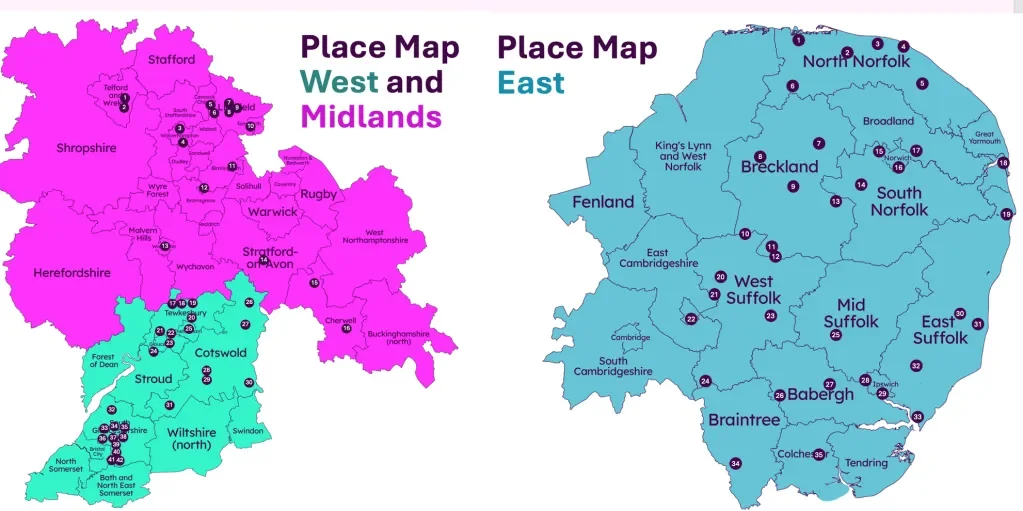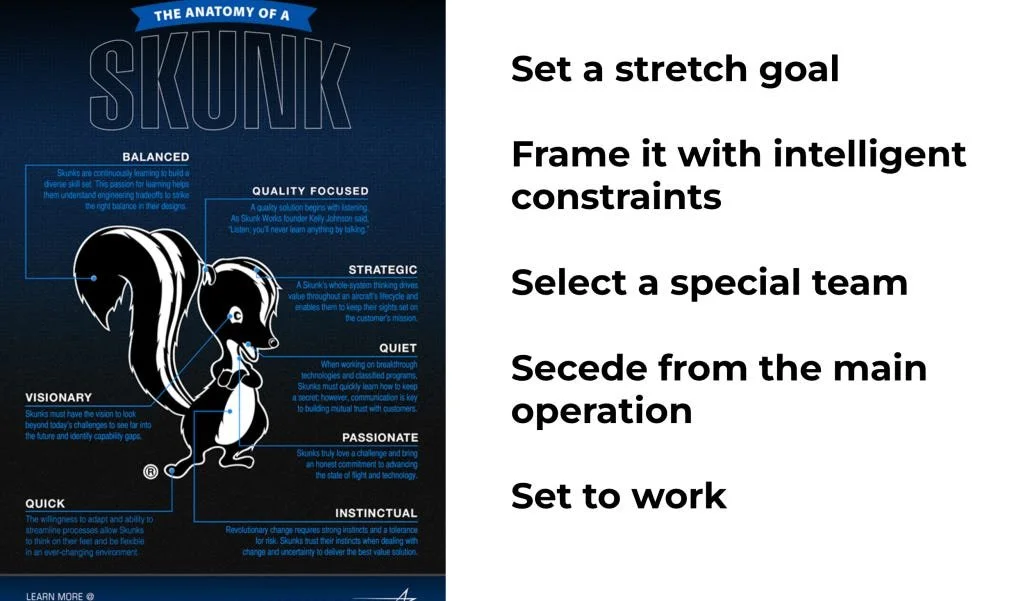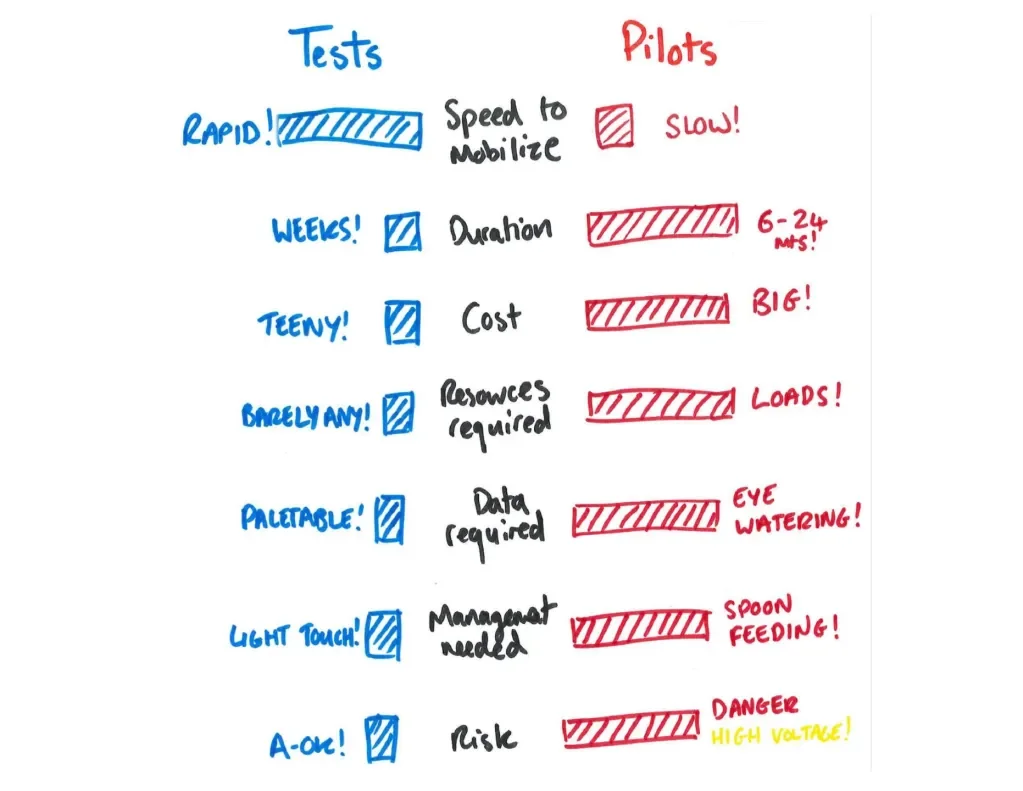The problem of organisations creating space for innovation and creative thinking, whilst prioritising business as usual, is anything but new.
The forerunners of modern innovation labs were corporate research and development (R&D) facilities established by major industrial firms in the early 1900s. These labs were designed to be engines of long-term, fundamental research, distinct from the day-to-day operations of the factory floor.
Bell Labs, founded by AT&T in 1925, is a prime example. The lab was lavishly funded by AT&T’s monopoly profits, which gave its scientists and engineers the freedom to pursue long-term, high-risk research without the pressure of a quick commercial return. It received nine Nobel Prizes for Physics.
A different, more agile model emerged during World War II with Lockheed Martin’s Advanced Development Programs, which became famously known as “Skunk Works.”
Lessons in Rapid Experiments and Learning From Failure
This team was given a radical mandate: bypass bureaucracy and deliver groundbreaking aircraft on impossibly short timelines. Working in semi-secrecy and with immense autonomy, they operated with a small, hand-picked team, minimal paperwork, and a direct line to leadership.
Skunk Works’ success was legendary, producing iconic aircraft like the U-2 spy plane, the SR-71 Blackbird, and the F-117 stealth fighter. Their philosophy, captured in “Kelly’s 14 Rules,” became a playbook for how a small team could out-innovate a large, bureaucratic organisation.
The concept of a “lab” was reborn in the 21st century in response to the accelerated pace of technological change and the threat of disruption from agile startups. Corporate labs were resurrected, but with a new mandate: to create discontinuous innovations and foster a culture of agility. These new labs often mimicked the appearance and work style of startups, using agile development and design thinking to rapidly prototype and test new ideas.
Simultaneously, the public sector began to adopt this model to address complex societal problems.The sector realised that traditional bureaucratic structures were ill-equipped to tackle “wicked problems” like climate change or social inequality. They needed a more experimental and human-centered approach, leading to the creation of social innovation labs.
MindLab, established by the Danish government in 2002, is a pioneering example and a personal inspiration. Unlike its corporate predecessors, its mission wasn’t to invent a new product but to co-create better public services. MindLab brought together citizens, businesses, and government officials to design solutions to complex issues like healthcare and education. Its success influenced similar initiatives worldwide, demonstrating that a lab could be a space for social experimentation and policy innovation, not just technological invention.
We were late to the party when we established the first housing sector innovation lab. It’s nearly 10 years since we did our ‘How To Build An Innovation Lab’ presentation at Google , a deck that’s been viewed over 60,000 times.
But, post pandemic, when our ways of working are completely changed, the traditional innovation lab is dead. Or at least, the idea of a single, siloed hub of creativity, tucked away in a corner, is no longer fit for purpose.
Innovation must be decentralised. It must be woven into the fabric of the organisation, a shared responsibility rather than a specialised function. This isn’t just a philosophical shift; it’s a strategic necessity, especially for an organisation like Bromford, which has grown and evolved through a merger with Flagship Group.
Our shift to a place-based approach requires a shift to a place centric innovation model. Just yesterday , I spent time with one of our place discovery teams and they are embedding non technology based practice in a way that a traditional innovation lab cannot.
Bromford Lab is dead. But what comes next?
And how can we build upon the lessons we learned?
From One Lab to a Hive Mind
Our merger will create a new, place-based structure which will have 77 distinct place based teams.
77 Innovation Labs. One Hive Mind
Each location will now be considered its own innovation lab. This model fundamentally changes how we approach problem-solving and improvement. Each of the 77 labs becomes a platform to test new ideas and different ways of working. The focus is on a continuous cycle of testing, learning, and sharing.
The results—both successes and failures—will then be shared with the entire organisation. This allows us to quickly identify what works and what doesn’t, making informed decisions about which innovations should be scaled up, spread or abandoned.
Place teams will have the ability to collaborate on similar problems. If Place Team 8, 12, and 33 have a identified similar challenge, they will be equipped with the autonomy to design and test solutions together.
For the larger, “big rock” challenges that can’t be solved at a local level or across multiple place teams, a new R+D approach will be established to provide strategic oversight and support.
77 Labs. One Hive Mind
A hive mind is a collective consciousness where the entire organisation acts as a single entity with shared goals and actions. This means moving away from internal protectionism and siloed thinking towards a unified vision centered on place based outcomes.
Achieving this hive mind requires a significant mental and operational shift. This model must foster a culture where every team member is empowered to contribute, creating a ecosystem of shared knowledge and collective intelligence. By embracing this decentralised, approach, we can break down silos, accelerate the pace of change, and ensure that innovation is not an isolated function and the preserve of a few.
That’s a lot of words, but yesterday, sitting with a place based team that now views the world as a system rather than a series of vertical silos, I could see the future.
Bromford Lab took us so far. Place Labs will take us far, far further.



